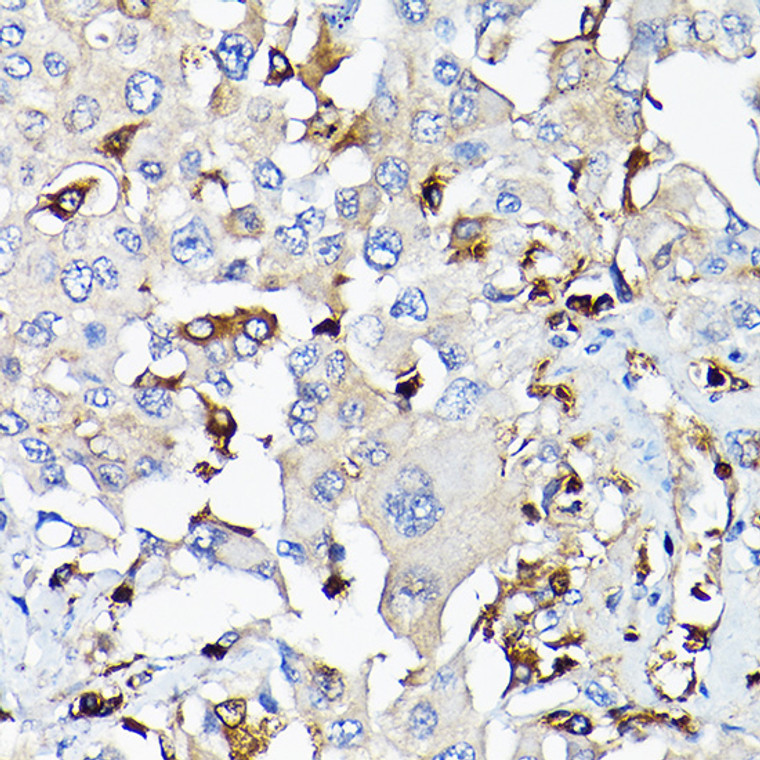| Host: |
Rabbit |
| Applications: |
WB/IHC |
| Reactivity: |
Human/Mouse |
| Note: |
STRICTLY FOR FURTHER SCIENTIFIC RESEARCH USE ONLY (RUO). MUST NOT TO BE USED IN DIAGNOSTIC OR THERAPEUTIC APPLICATIONS. |
| Short Description: |
Rabbit polyclonal antibody anti-IGF1 (50-150) is suitable for use in Western Blot and Immunohistochemistry research applications. |
| Clonality: |
Polyclonal |
| Conjugation: |
Unconjugated |
| Isotype: |
IgG |
| Formulation: |
PBS with 0.05% Proclin300, 50% Glycerol, pH7.3. |
| Purification: |
Affinity purification |
| Dilution Range: |
WB 1:500-1:2000IHC-P 1:50-1:200 |
| Storage Instruction: |
Store at-20°C for up to 1 year from the date of receipt, and avoid repeat freeze-thaw cycles. |
| Gene Symbol: |
IGF1 |
| Gene ID: |
3479 |
| Uniprot ID: |
IGF1_HUMAN |
| Immunogen Region: |
50-150 |
| Immunogen: |
A synthetic peptide corresponding to a sequence within amino acids 50-150 of human IGF1 (NP_000609.1). |
| Immunogen Sequence: |
PETLCGAELVDALQFVCGDR GFYFNKPTGYGSSSRRAPQT GIVDECCFRSCDLRRLEMYC APLKPAKSARSVRAQRHTDM PKTQKEVHLKNASRGSAGNK N |
| Function | The insulin-like growth factors, isolated from plasma, are structurally and functionally related to insulin but have a much higher growth-promoting activity. May be a physiological regulator of 1-14C-2-deoxy-D-glucose (2DG) transport and glycogen synthesis in osteoblasts. Stimulates glucose transport in bone-derived osteoblastic (PyMS) cells and is effective at much lower concentrations than insulin, not only regarding glycogen and DNA synthesis but also with regard to enhancing glucose uptake. May play a role in synapse maturation. Ca(2+)-dependent exocytosis of IGF1 is required for sensory perception of smell in the olfactory bulb. Acts as a ligand for IGF1R. Binds to the alpha subunit of IGF1R, leading to the activation of the intrinsic tyrosine kinase activity which autophosphorylates tyrosine residues in the beta subunit thus initiatiating a cascade of down-stream signaling events leading to activation of the PI3K-AKT/PKB and the Ras-MAPK pathways. Binds to integrins ITGAV:ITGB3 and ITGA6:ITGB4. Its binding to integrins and subsequent ternary complex formation with integrins and IGFR1 are essential for IGF1 signaling. Induces the phosphorylation and activation of IGFR1, MAPK3/ERK1, MAPK1/ERK2 and AKT1. |
| Protein Name | Insulin-Like Growth Factor IIgf-IMechano Growth FactorMgfSomatomedin-C |
| Database Links | Reactome: R-HSA-114608Reactome: R-HSA-2404192Reactome: R-HSA-2428928Reactome: R-HSA-2428933Reactome: R-HSA-381426Reactome: R-HSA-422085 |
| Cellular Localisation | Secreted |
| Alternative Antibody Names | Anti-Insulin-Like Growth Factor I antibodyAnti-Igf-I antibodyAnti-Mechano Growth Factor antibodyAnti-Mgf antibodyAnti-Somatomedin-C antibodyAnti-IGF1 antibodyAnti-IBP1 antibody |
Information sourced from Uniprot.org
12 months for antibodies. 6 months for ELISA Kits. Please see website T&Cs for further guidance








